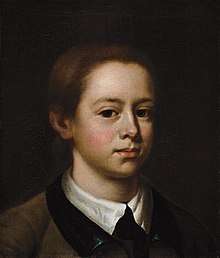Richard Puller
Richard Puller (1747–1826) was a prominent English merchant banker in London.[1] He has sometimes[2] been identified as the pseudonymous economic writer Piercy Ravenstone, considered a precursor of Karl Marx; but scholarly sources generally now follow the suggestion of Piero Sraffa that Ravenstone was Richard Puller the younger (1789–1831), his son.

Life
He was the son of Christopher Puller (died 1789), also a prominent London merchant banker. His father was a director of the Bank of England, while he was a director of the South Sea Company;[1][2][3]
Richard and Charles Puller, of 10 Broadstreet Buildings, were the London bankers of John Adams during the 1780s; Adams refers also to the firm as Conde & Puller.[4][5][6] This was also the period of the Fourth Anglo-Dutch War, and Richard Puller acted as an agent in a case concerning a captured Dutch ship.[7]
In later life Puller resided at Painswick Court in Gloucestershire. He died there, on 5 December 1826.[2][8]
Family
Puller married Selina Wall, daughter of Thomas Wall of Albury Park, Surrey.[9] (Wall is so called. The Wall family of Albury Park were Charles Wall of Barings Bank and his wife Francis, daughter of Sir Francis Baring; they were the parents of Charles Baring Wall, the Member of Parliament. The house was bought in 1811 from Samuel Thornton, sold in 1819 to Henry Drummond.[10][11][12] Charles Wall's parents were Thomas Wall (1721–1812) and Elizabeth Ellis.[13]) The following were their children:
- Sir Christopher Puller (1774–1824)[2]
- Henry Puller (1782–1813), an officer in the Bengal Army. He died at Rangpur.[14]
- Richard Puller the younger (1789–1831). He is now the usual identification of the pseudonymous economic writer, Piercy Ravenstone. It has also been suggested that the elder Richard Puller might be Ravenstone, and this identification is made in the Oxford Dictionary of National Biography.[2][15]
- Harriet, who married John Norman Pearson.[16]
- Charlotte Louisa[17]
- Selina Eliza, the third daughter, married John Cholmondeley, rector of Brandiston.[18] He was a brother of Sir Montague Cholmeley, 1st Baronet.[19]
Notes
- John Tregenza (1968). Professor of Democracy. Melbourne University Press. p. 7.
- Potier, Jeanne. "Puller, Sir Christopher". Oxford Dictionary of National Biography (online ed.). Oxford University Press. doi:10.1093/ref:odnb/22882. (Subscription or UK public library membership required.)
- William Stafford (24 April 1987). Socialism, Radicalism, and Nostalgia: Social Criticism in Britain, 1775-1830. Cambridge University Press. p. 209. ISBN 978-0-521-33989-6.
- John Adams; Gregg L. Lint (1977). Papers of John Adams: June 1783-January 1784. Harvard University Press. p. 319 note 2. ISBN 978-0-674-05123-2.
- "From John Adams to Richard Puller, 27 September 1789". Retrieved 5 January 2020. [This is an Early Access document from The Adams Papers. It is not an authoritative final version.]. Also available as captured by Internet Archive on 5 January 2020. From John Adams to Richard Puller, 27 September 1789.
- "Papers of John Adams, Volume 15, From Wilhem & Jan Willink, Nicolaas & Jacob van Staphorst, and De la Lande & Fynje, MHS Digital Edition: Adams Papers". Retrieved 23 December 2015.
- Gert Oostindie; Jessica V. Roitman (20 June 2014). Dutch Atlantic Connections, 1680-1800: Linking Empires, Bridging Borders. BRILL. p. 289 note 45. ISBN 978-90-04-27131-9.
- The Gentleman's Magazine. A. Dodd and A. Smith. 1826. p. 572.
- Burke, Sir Bernard (1894). "A genealogical and heraldic history of the landed gentry of Great Britain & Ireland". London: Harrison & Sons. p. 539. Retrieved 23 December 2015.
- Prosser, George Frederick (1828). "Select Illustrations of the County of Surrey: Comprising ... Views of the ..." Internet Archive. Rivington. Retrieved 23 December 2015.
- Alan Munden, Thomas Snow and the Western Schism (PDF) at p. 332
- "Wall, Charles Baring (1795–1853), of Norman Court, East Tytherley, Hants., History of Parliament Online". Retrieved 23 December 2015.
- Sir Bernard Burke (1852). A genealogical and heraldic dictionary of the landed gentry of Great Britain & Ireland for 1852. Colburn and Company. p. 1494.
- Vernon Charles Paget Hodson (1946). List of the Officers of the Bengal Army, 1758-1834: L-R. Constable. p. 583.
- Nigel F. B. Allington (13 December 2010). English, Irish and Subversives Among the Dismal Scientists. Emerald Group Publishing. p. 306. ISBN 978-0-85724-062-0.
- Matthew, H. C. G. "Pearson, John Norman". Oxford Dictionary of National Biography (online ed.). Oxford University Press. doi:10.1093/ref:odnb/21721. (Subscription or UK public library membership required.)
- David Ricardo; Piero Sraffa (22 November 1973). The Works and Correspondence of David Ricardo: Volume 11, General Index. Cambridge University Press. p. xxix. ISBN 978-0-521-20039-4.
- The Gentleman's Magazine: 1810. E. Cave. 1810.
- John Debrett (1840). The baronetage of England. revised, corrected and continued by G. W. Collen. p. 112.